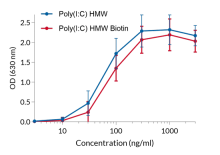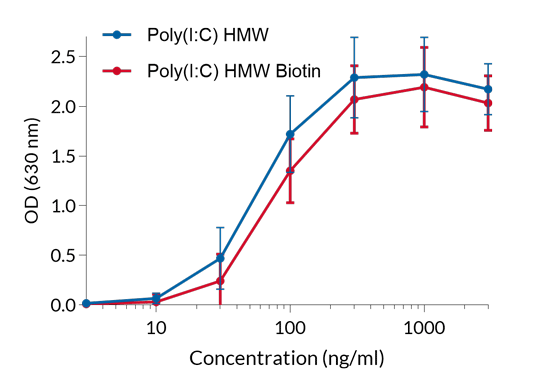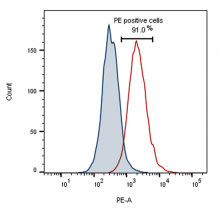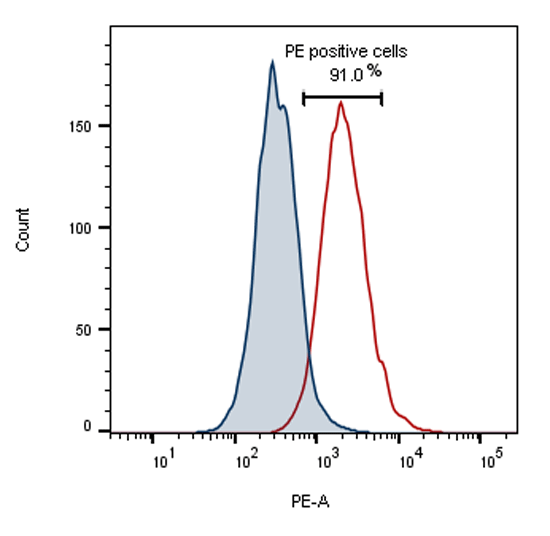Poly(I:C) (HMW) Biotin
| Product | Unit size | Cat. code | Docs. | Qty. | Price | |
|---|---|---|---|---|---|---|
|
Poly(I:C) (HMW) Biotin Biotin-labeled polyinosine-polycytidylic acid |
Show product |
10 µg |
tlrl-picb
|
|
Biotin-labeled synthetic analog of dsRNA

TLR3 activation by Poly(I:C) Biotin
Poly(I:C) HMW Biotin is biotin-labeled Toll-like receptor 3 (TLR3) agonist. It was chemically produced by covalent coupling of biotin with high molecular weight polyinosinic-polycytidylic acid (poly(I:C) HMW). Poly(I:C) HMW, with an average size of 1.5-8 kb, comprises long strands of inosine poly(I) homopolymer annealed to strands of cytidine poly(C) homopolymer. The labeled ligand retains the biological activity of poly(I:C).
Poly(I:C) is a synthetic analog of double-stranded RNA (dsRNA), a molecular pattern associated with viral infection. Both natural and synthetic dsRNAs are known to induce type I interferon (IFN) production [1]. Depending on its location in the cell, poly(I:C) can activate distinct pattern recognition receptor (PRR) pathways: endosomal poly(I:C) activates TLR3 [2], whereas cytosolic poly(I:C) activates retinoic acid-inducible protein I (RIG-I) [3], melanoma differentiation-associate gene 5 (MDA-5) [4], and protein kinase RNA-activated (PKR) [5]. Activation of these PRRs results in the induction of multiple signaling pathways, including NF-κB and IFN regulatory factors (IRFs).
Poly(I :C) HMW Biotin can be used for various applications, including histochemical staining, cytometry, fluorescence microscopy, and ligand binding assays [6, 7].
InvivoGen's Poly(I :C) HMW Biotin is of the highest quality and guaranteed free of bacterial contamination. Each lot is thoroughly tested to ensure the absence of lot-to-lot variation.
Key features of Poly(I:C) Biotin:
- Potent inducer of TLR3 activity
- Designed to assess Poly(I:C) binding
- Each lot is functionally tested
References:
1. Kawasaki T. & Kawai T., 2014. Toll-like receptor signaling pathways. Front Immunol. 5:461.
2. Alexopoulou L. et al., 2001. Recognition of double-stranded RNA and activation of NF-κB by Toll-like receptor 3. Nature, 413:732-8.
3. Kawai T. & Akira S., 2008. Toll-like receptor and RIG-I-like receptor signaling. Ann N Y Acad Sci. 1143:1-20.
4. McCartney S. et al., 2009. Distinct and complementary functions of MDA5 and TLR3 in poly(I:C)-mediated activation of mouse NK cells. J Exp Med. 206(13):2967-76.
5. Lemaire P.A. et al., 2008. Mechanism of PKR Activation by dsRNA. J Mol Biol. 381(2):351-60.
6. Hasan M. et al, 2011. Antimicrobial peptides inhibit polyinosinic-polycytidylic acid-induced immune responses. J Immunol. 187(11):5653-9.
7. Sugimoto N. et al., 2014. Helicase proteins DHX29 and RIG-I cosense cytosolic nucleic acids in the human airway system. PNAS. 111(21):7747-52.
Specifications
Specificity: TLR3 agonist
Synonym: Biotinylated poly I:C
Solubility: 100 µg/ml in H2O
Working concentration: 30 ng - 1 μg/ml
Quality control:
- TLR3 activity has been verified using HEK-Blue™ hTLR3 cells.
- Biotin coupling has been validated by flow cytometry.
- The absence of bacterial contamination (lipoproteins and endotoxins) has been confirmed using HEK-Blue-Lucia™ hTLR2 and HEK-Blue-Lucia™ mTLR4 cells.
Contents
Poly(I:C) HMW Biotin is provided lyophilized:
- 10 µg Poly(I:C) HMW Biotin
- 1.5 ml endotoxin-free water
![]() Poly(I:C) HMW Biotin is shipped at room temperature
Poly(I:C) HMW Biotin is shipped at room temperature
![]() Upon receipt it should be stored at -20°C for up to 6 months.
Upon receipt it should be stored at -20°C for up to 6 months.
Upon resuspension, Poly(I:C) HMW Biotin should be aliquoted and stored at -20˚C.
Resuspended product is stable 3 months at -20°C.
Avoid repeated freeze-thaw cycles.
Back to the top







